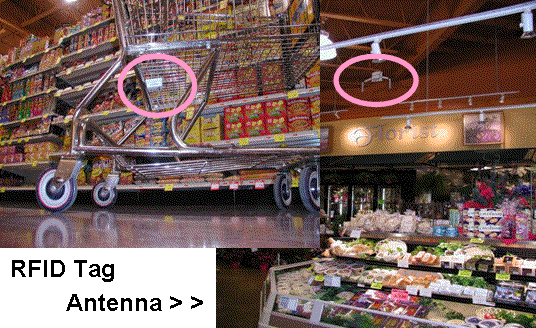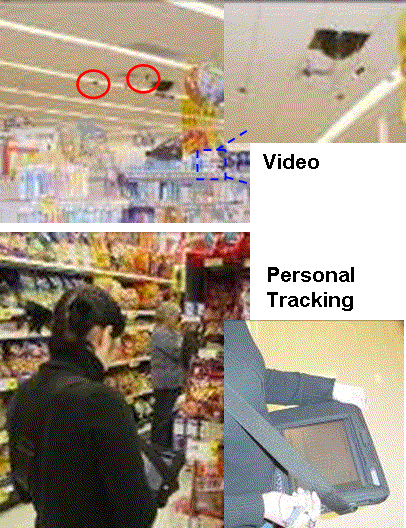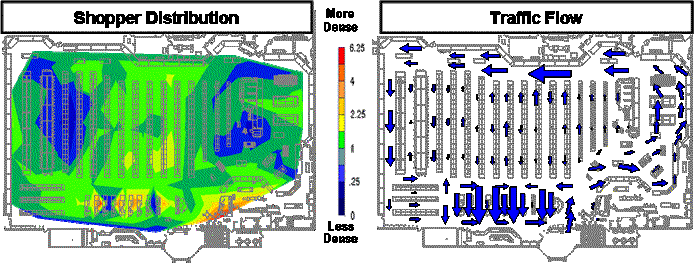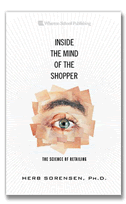The First Face
These Views are informed by a study of millions of shopping trips, on a second by second basis. What does that mean? In 2001 we began tracking shoppers from the cart corral to the checkout line, by tagging their carts (and baskets) with RFID tags. Of course, this use of the cart's location as a surrogate of the shoppers location can't be precisely correct at all times. Fortunately, we could  measure that wandering from the cart, to a certain extent, by knowing the exact location of every item in the store, as well as what purchases occured with each cart, as revealed by linking the transaction log of purchase scans at the checkout - when the cart arrived at checkout. So any time a purchase was of a product that didn't lie on the path of the cart, it was because the shopper had wandered from the cart to purchase it. This was the beginning of PathTracker®, tracking the paths of shoppers.
measure that wandering from the cart, to a certain extent, by knowing the exact location of every item in the store, as well as what purchases occured with each cart, as revealed by linking the transaction log of purchase scans at the checkout - when the cart arrived at checkout. So any time a purchase was of a product that didn't lie on the path of the cart, it was because the shopper had wandered from the cart to purchase it. This was the beginning of PathTracker®, tracking the paths of shoppers.
This allowed us to know exactly where the shopper was at all times, how fast they were walking, when they slowed or stopped, for how long, in front of what products, if they purchased, etc. The result was the creation of the most robust suite of shopper data, along with an analytical system to examine it.
So this is the first face of PathTracker®, essentially electronically tracking shoppers (or their baskets), and on a close to census basis - tens or hundreds of thousands of shoppers in a typical supermarket over weeks or months. This is significant because the mass of data allowed small distinctions that might never be apparent, even across dozens of stores.
The Second Face
The problem with this electronic tracking is less about the cart-surrogate issue, and more about the the problem of stores that do not even use carts or baskets - or use few of them. As someone said, seeing is believing, so beginning in 2002 we began widespread deployment of a variety of visual tracking methods. The first of these was digital video in a convenience store in Southern California.  Not only did this extend the channels that could be studied, but it provided vital confirmation of the methodology and analysis. For example, study of a series of matched gift stores in 2003 confirmed that the effect of right-handedness in supermarkets and C-stores extended to non-food channels, later confirmed in autoparts stores, also.
Not only did this extend the channels that could be studied, but it provided vital confirmation of the methodology and analysis. For example, study of a series of matched gift stores in 2003 confirmed that the effect of right-handedness in supermarkets and C-stores extended to non-food channels, later confirmed in autoparts stores, also.
The matched panel nature of these studies first identified the principle that "the harder it is for a shopper to get to a store (remoteness, isolation) the more thoroughly shoppers will shop the store." It's intuitive, once you know it. In fact, the "aisleness of stores," discussed in the first issue of these new Views, was first discovered in a series of smaller stores, where the phenomena was creating radical departures from normative data observed earlier.
Visually tracking shoppers on a second by second basis typically involves at most a few thousand shoppers, but the analysis now benefits from a large base of earlier studies providing great insight into smaller samples. The actual methodology for the tracking is always technology-enabled, but varies from full store video (as in the earlier studies) to full store eye-tracking studies, either of the field of vision or point-of-focus variety. One of our favorites is simply shadowing shoppers who have given their approval, and recording every movement on a web tablet. This has the advantage of requiring no installation of equipment in the store, so it is very conveniently integrated into a survey research study - at the same time providing the full suite of PathTracker® measures: category or product reach, stopping power, holding power, closing power, etc.
The Third Face
Several years ago we recognized that many of the statistics provided by PathTracker®, whether of the full store, or for single categories, could be measured simply without a full tracking operation, using valid statistical sampling of zones, categories, etc. This led to the development of a robust suite of Audit PathTracker® methods. In some cases, these carefully controlled samplings provide the gold standard of traffic and conversion measures.

The Three Dimensions of the Shopping Trip
The above is a simple summary of the methodology. I've written a book about the application and learnings, scheduled to be published in May of 2009 by The Wharton School Publishers. Our shopper research is founded on the paths of shoppers, and the statistics about the "shopping crowd," the third face. But we are now moving well beyond the physical path and shopper behavior that can be learned from that path (the first dimension,) to the path traced by their eyes in the store, both in terms of their exact point of focus and their total field of vision (the second dimension,) and more recently wedding the foot and eye to the brain (the third dimension,) with biometrics of brain-waves, galvanic skin response, etc. All three dimensions of the shopper are the simultaneous focus of our advanced HyperEyeCam.


